Upon opening Conqueror, the default game appears:
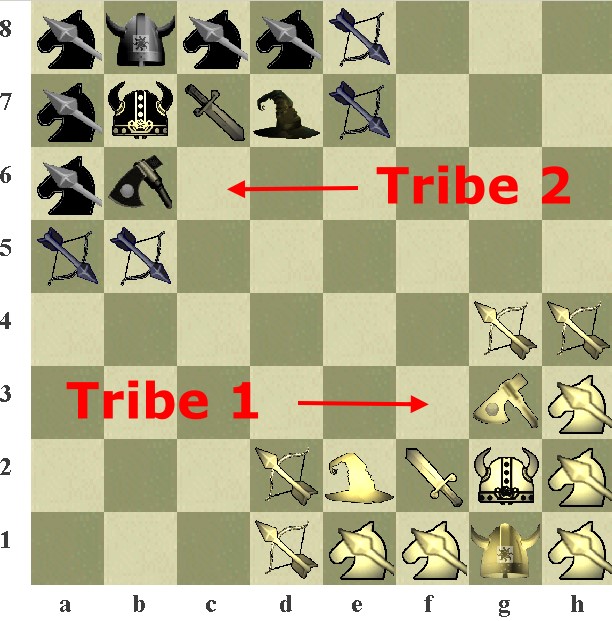
Two tribes occupy either side of the board. White pieces denote one tribe, black pieces denote the opposing tribe. By default, white always moves first.
The pieces, in increasing order of rank, are:
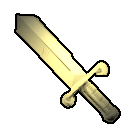
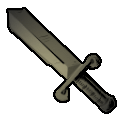 SWORDSMAN, moves 1 square on diagonals.
SWORDSMAN, moves 1 square on diagonals.
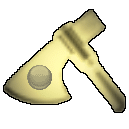
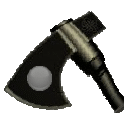 ASSASSIN, moves one or two squares on the horizontal and vertical.
ASSASSIN, moves one or two squares on the horizontal and vertical.
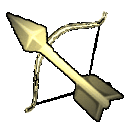
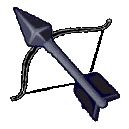 ARCHER, moves 1 square in any direction.
ARCHER, moves 1 square in any direction.
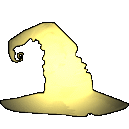
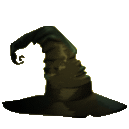 MAGICIAN, moves 1 square on horizontal and vertical. Can cast spells
on enemy pieces up to 2 squares, demoting them to lower-ranking pieces.
MAGICIAN, moves 1 square on horizontal and vertical. Can cast spells
on enemy pieces up to 2 squares, demoting them to lower-ranking pieces.
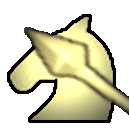
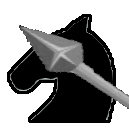 WARRIOR (mounted bowman), moves 2 squares in any direction.
WARRIOR (mounted bowman), moves 2 squares in any direction.
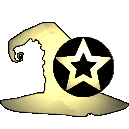
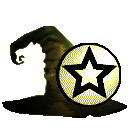 POWER MAGICIAN, moves 2 squares on horizontal and vertical (similar
to WARRIOR). Can cast spells on enemy pieces up to 2 squares, demoting
them to lower-ranking pieces.
POWER MAGICIAN, moves 2 squares on horizontal and vertical (similar
to WARRIOR). Can cast spells on enemy pieces up to 2 squares, demoting
them to lower-ranking pieces.
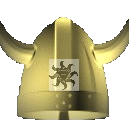
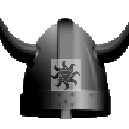 BONDSMAN: mounted bowman having all the movements of the WARRIOR with
extended 3 square range on the horizontal and vertical. This is the
khan's right hand man (the first bondsman), and is the backup leader
of the tribe.
BONDSMAN: mounted bowman having all the movements of the WARRIOR with
extended 3 square range on the horizontal and vertical. This is the
khan's right hand man (the first bondsman), and is the backup leader
of the tribe.

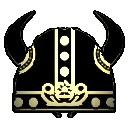 KHAN, is the main leader of the tribe. The piece moves like a WARRIOR
with an extended 3 square range on the horizontal and vertical and diagonal.
KHAN, is the main leader of the tribe. The piece moves like a WARRIOR
with an extended 3 square range on the horizontal and vertical and diagonal.
To win, a player must capture both the enemy Khan and the Bondsman.
Sample opening moves
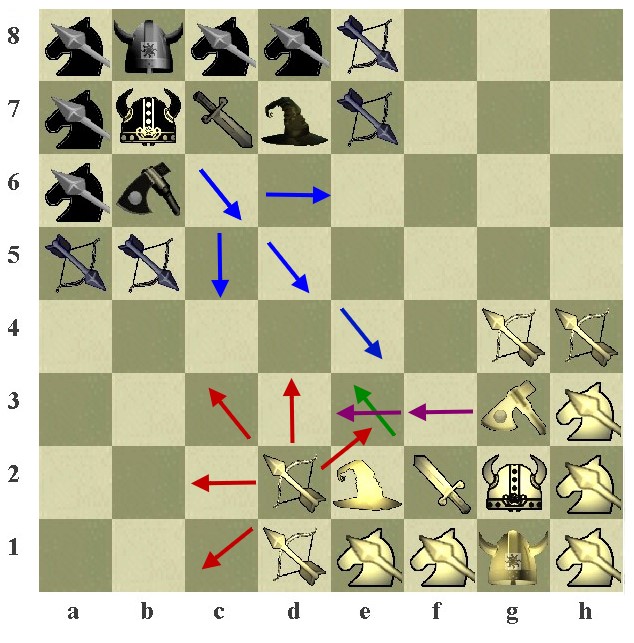
In the above diagram,
 The white
archer at square D2, can move to 5 positions (see red arrows). The piece
is blocked in the other directions by the white magician at square E2
and the white archer at square D1.
The white
archer at square D2, can move to 5 positions (see red arrows). The piece
is blocked in the other directions by the white magician at square E2
and the white archer at square D1.
 The white
swordsman at F2 can move to only one square (see green).
The white
swordsman at F2 can move to only one square (see green).
 The white
assassin at G3 can move to two squares (see purple).
The white
assassin at G3 can move to two squares (see purple).
 The black
khan at B7 can move to 5 possible squares (see blue arrows). The other
squares like B6 and B5 are blocked by surrounding pieces.
The black
khan at B7 can move to 5 possible squares (see blue arrows). The other
squares like B6 and B5 are blocked by surrounding pieces.
None of the warrior (W) pieces of either side can move because they
are blocked. (Pieces cannot move off the board)
Making a move on the board:
To make a move, drag one of the white pieces to a legal square. Black will now make a move (the computer). The default is 3 seconds per move. If you wish to adjust the skill level or choose another move time, choose Game..Players, or Game..Rated Players.
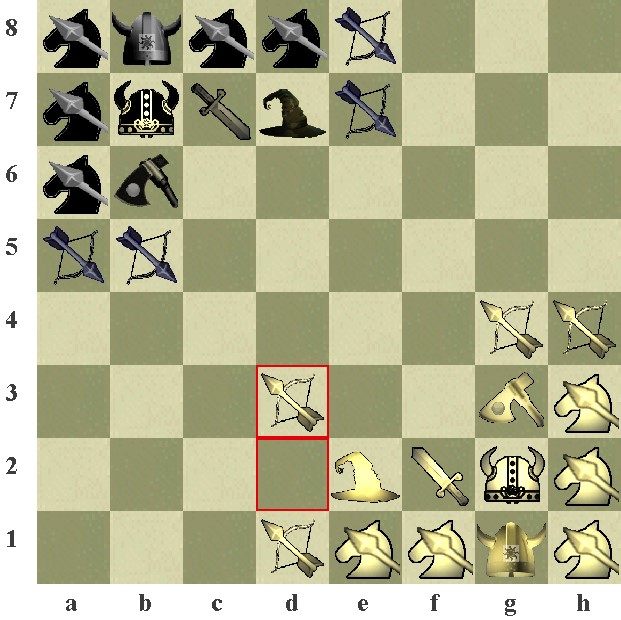
If you're not happy with your move, you can always select Game..Takeback move. Select twice to take back the computer move and your move.
Displaying a piece's legal moves:
If you are stuck and don't know which moves a piece can make, use the Control-Mouse-click function. Press the Control key while mouse clicking on any piece on the board. (On a mac this would be Command-Click). You will see the square(s) hilighted in blue for this piece's legal moves:
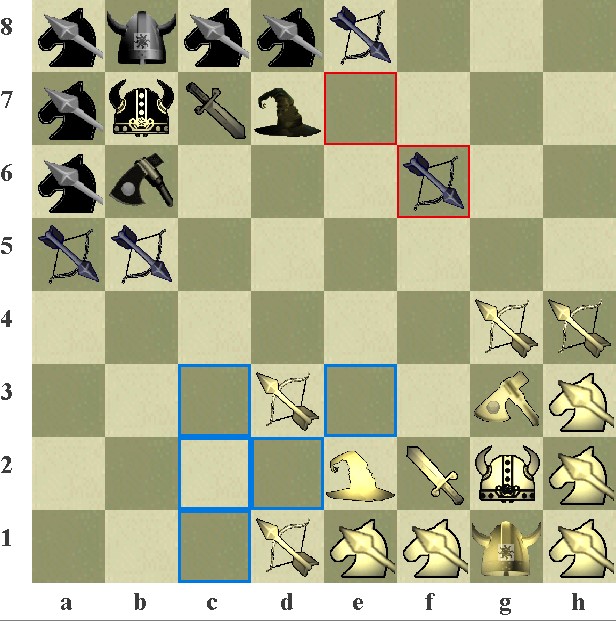
The blue squares above show the legal moves for the piece clicked (in my case, the white warrior at E1).
The red squares denotes the last move made. In this case, this was the computer's move, E7 to F6.
More piece movements:
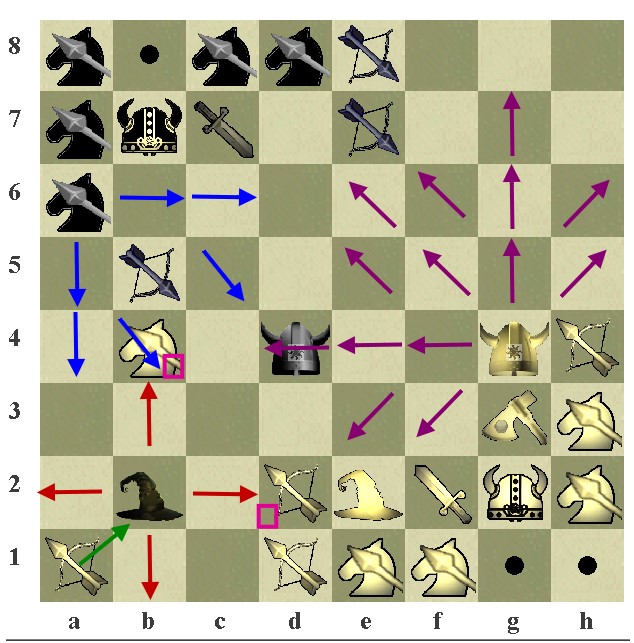
 Above, the
white bondsman at square G4, can move to many positions (see purple
arrows). Note the extended 3 square range on the horizontal and vertical.
The white bondsman can capture the black bondsman at D4, but no other
black pieces.
Above, the
white bondsman at square G4, can move to many positions (see purple
arrows). Note the extended 3 square range on the horizontal and vertical.
The white bondsman can capture the black bondsman at D4, but no other
black pieces.
 The black
magician at B2 can physically move to any of the red squares, only 1
square in the horizontal and vertical.
The black
magician at B2 can physically move to any of the red squares, only 1
square in the horizontal and vertical.
The piece can cast spells on the white archer at D2, demoting it to
the next down in rank (a Swordsman), or cast spells on the white knight
at B4, demoting it to an Archer, the next down in rank.
 In turn,
the white archer at A1 can capture the black magician (see the green
arrow).
In turn,
the white archer at A1 can capture the black magician (see the green
arrow).
 The black
warrior at A6 can move to any of the blue squares, moving 2 squares
in any direction. It can only capture the white warrior at B4.
The black
warrior at A6 can move to any of the blue squares, moving 2 squares
in any direction. It can only capture the white warrior at B4.
Move summary:
If a piece is at centre position D5, below, the potential range of moves are:
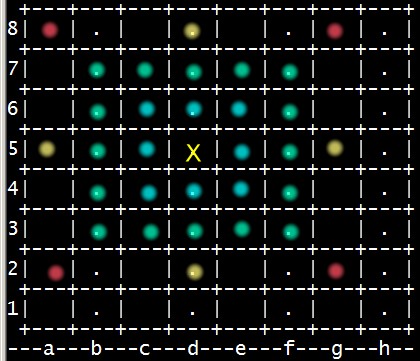

 Archer: (can move to blue squares)
Archer: (can move to blue squares)
 Warrior: (can move to blue and green squares)
Warrior: (can move to blue and green squares)
 Bondsman: (blue + green + yellow)
Bondsman: (blue + green + yellow)
 Khan: (blue + green + yellow + red)
Khan: (blue + green + yellow + red)
Magicians:

 Magicians are advanced pieces which can move according to the following
move table:
Magicians are advanced pieces which can move according to the following
move table: 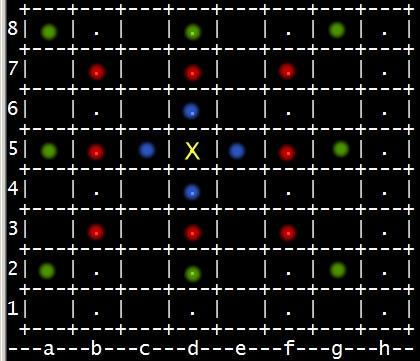
MAGICIAN RULE: If a magician (M) is at square 'x', then he can physically move to any of the BLUE squares, provided they are UNOCCUPIED, or, he can cast spells on enemies residing on any of the blue OR red squares. After casting his spell he does not move from his position at 'X'.
MAGICIAN RULE: Magicians cannot capture enemy pieces. They can only 'demote' them to the next lower rank.
For example, if an enemy Archer is at square B7, then the magician at x can demote him to rank 'S' (SWORDSMAN).
This is equivalent to the magician fouling the archer's bow, or leaving the Archer with only a sword to fight with.
Likewise, if an enemy Warrior (bondsman, warrior or khan) is at square D3, then the magician can demote him to rank 'A', or ARCHER. This is equivalent to the magician fouling the warrior's horse, or leaving the Warrior stranded with only a bow to fight with.
Additional rules for power magicians and low magicians:
 Power
magicians are magicians on horses, graced with the same moving
principles as regular magicians except they enjoy the range of mounted
warriors to unoccupied squares.
Power
magicians are magicians on horses, graced with the same moving
principles as regular magicians except they enjoy the range of mounted
warriors to unoccupied squares. 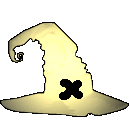 Low
magicians are magicians that have been demoted to lower caste.
They have the same moving principles as regular magicians except they
can only cast spells up to 1 square, not 2.
Low
magicians are magicians that have been demoted to lower caste.
They have the same moving principles as regular magicians except they
can only cast spells up to 1 square, not 2. Extending a magician's range:
Magician spells can be extended to the green marked circles (above) by selecting Game..Rules:
See customizing the game for details...
A synopsis of piece movements
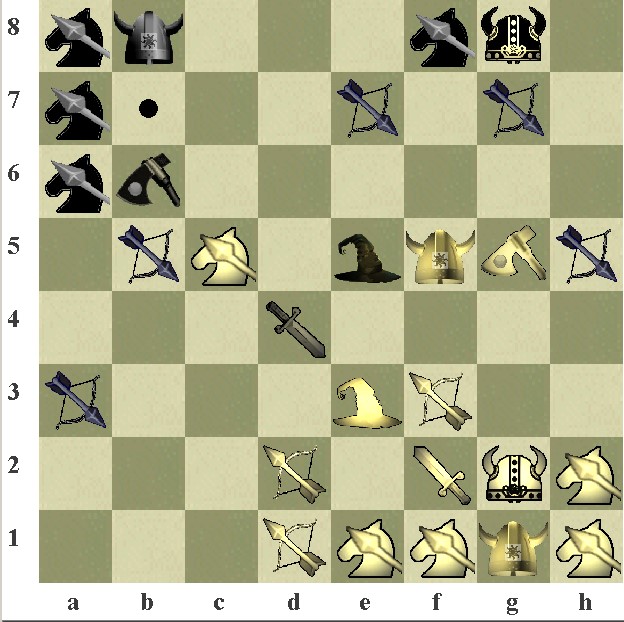
 The
archer at B5 can capture the white warrior at C5.
The
archer at B5 can capture the white warrior at C5.  The warrior
at C5 can capture the archer.
The warrior
at C5 can capture the archer.  The white
warrior cannot capture the black warrior at A6, because its path is blocked
by the pieces at B5 and B6.
The white
warrior cannot capture the black warrior at A6, because its path is blocked
by the pieces at B5 and B6. Likewise, the black warrior at A6 cannot capture the white warrior at C5.
 The white
warrior can capture the black magician at E5. The magician cannot capture
the white warrior because of his innate rule of not being able to kill
enemies, but he can demote the warrior to the next lower in rank (Archer).
The white
warrior can capture the black magician at E5. The magician cannot capture
the white warrior because of his innate rule of not being able to kill
enemies, but he can demote the warrior to the next lower in rank (Archer).
 The magician
can also demote the assassin at G5 to a swordsman,
The magician
can also demote the assassin at G5 to a swordsman,  casting his xray spell through the bondsman.
casting his xray spell through the bondsman. The magician
can also demote the white enemy magician at E3 to a lower ranking one
(M-)
The magician
can also demote the white enemy magician at E3 to a lower ranking one
(M-)  that
can only move one square on the horizontal and vertical, thus severely
limiting his spell-casting ability. If it were white's turn to move, the
magician at E3 could similarly cast a spell on E5 and demote him to a
lower ranking piece.
that
can only move one square on the horizontal and vertical, thus severely
limiting his spell-casting ability. If it were white's turn to move, the
magician at E3 could similarly cast a spell on E5 and demote him to a
lower ranking piece. 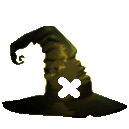
 The Assassin
at G5 (which has 2 squares mobility in horizontal or vertical directions)
cannot capture the magician at E5 because it is blocked by F5 by F. He
can capture the archer at H5 and G7 though. He cannot attack the white
Khan at G2 because the Khan is outside his range, but the Khan at G2 can
capture him because he is within his attack range (3 squares on the horizontal,
vertical or diagonal).
The Assassin
at G5 (which has 2 squares mobility in horizontal or vertical directions)
cannot capture the magician at E5 because it is blocked by F5 by F. He
can capture the archer at H5 and G7 though. He cannot attack the white
Khan at G2 because the Khan is outside his range, but the Khan at G2 can
capture him because he is within his attack range (3 squares on the horizontal,
vertical or diagonal).  The bondsman
at F5 can capture the black warrior at F8 because he has 3 square range
on the horizontal and vertical.
The bondsman
at F5 can capture the black warrior at F8 because he has 3 square range
on the horizontal and vertical. But the black warrior cannot capture F, which is out of range as warriors have only a 2 square mobility.
 The
black swordsman at D4 can capture the magician at E3, but he cannot capture
mounted pieces like W at C5.
The
black swordsman at D4 can capture the magician at E3, but he cannot capture
mounted pieces like W at C5. This is because a swordsman could never kill a mounted bowman in real life. He would get ridden down or bowed down in short order.
Note: this rule can be changed. Select Game..Rules to allow swordsmen to capture mounted pieces.